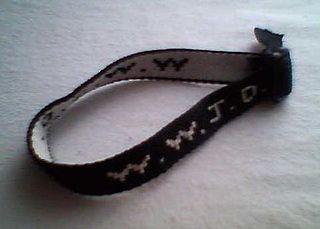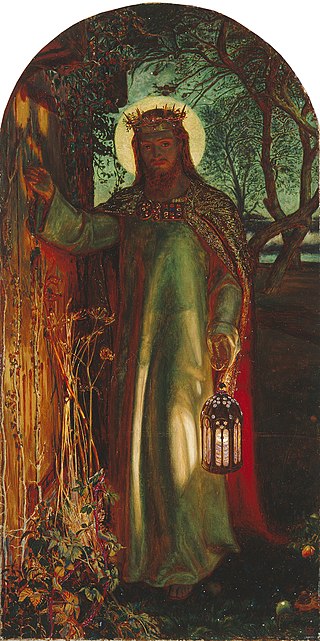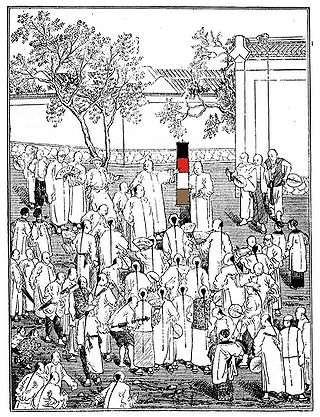Related Research Articles
Born again, or to experience the new birth, is a phrase, particularly in evangelicalism, that refers to a "spiritual rebirth", or a regeneration of the human spirit. In contrast to one's physical birth, being "born again" is distinctly and separately caused by the operation of the Holy Spirit, it is not caused by baptism in water. It is a core doctrine of the denominations of the Anabaptist, Moravian, Methodist, Baptist, Plymouth Brethren and Pentecostal Churches along with all other evangelical Christian denominations. All of these Churches strongly believe Jesus's words in the Gospels: "You must be born again before you can see, or enter, the Kingdom of Heaven." Their doctrines also mandate that to be both "born again" and "saved", one must have a personal and intimate relationship with Jesus Christ.

Easter eggs, also called Paschal eggs, are eggs that are decorated for the Christian feast of Easter, which celebrates the resurrection of Jesus. As such, Easter eggs are common during the season of Eastertide. The oldest tradition, which continues to be used in Central and Eastern Europe, is to use dyed and painted chicken eggs.
Quinquagesima, in the Western Christian Churches, is the last Sunday of Shrovetide, being the Sunday before Ash Wednesday. It is also called Quinquagesima Sunday, Quinquagesimae, Estomihi, Shrove Sunday, Pork Sunday, or the Sunday next before Lent.

In Christianity, evangelism or witnessing is the act of preaching the gospel with the intention of sharing the message and teachings of Jesus Christ.

The phrase "What would Jesus do?", often abbreviated to WWJD, became popular particularly in the United States in the early 1900s after the widely read book by Charles Sheldon entitled, In His Steps: What Would Jesus Do?. The phrase had a resurgence in the US and elsewhere in the 1990s and as a personal motto for adherents of Christianity who used the phrase as a reminder of their belief in a moral imperative to act in a manner that would demonstrate the love of Jesus through the actions of the adherents.

A bracelet is an article of jewellery that is worn around the wrist. Bracelets may serve different uses, such as being worn as an ornament. When worn as ornaments, bracelets may have a supportive function to hold other items of decoration, such as charms. Medical and identity information are marked on some bracelets, such as allergy bracelets, hospital patient-identification tags, and bracelet tags for newborn babies. Bracelets may be worn to signify a certain phenomenon, such as breast cancer awareness, or for religious/cultural purposes.
In the Eastern Orthodox Church, the feast of the Resurrection of Jesus, called Pascha (Easter), is the greatest of all holy days and as such it is called the "feast of feasts". Immediately below it in importance, there is a group of Twelve Great Feasts. Together with Pascha, these are the most significant dates on the Orthodox liturgical calendar. Eight of the great feasts are in honor of Jesus Christ, while the other four are dedicated to the Virgin Mary — the Theotokos.

Gel bracelets are a type of wristband often made from silicone.

The Sinner's prayer is an evangelical Christian term referring to any prayer of repentance, prayed by individuals who feel sin in their lives and have the desire to form or renew a personal relationship with God through Jesus Christ. It is a popular prayer in evangelical circles. It is not intended as liturgical like a creed or a confiteor said or chanted within the Catholic Mass, but rather, is intended to be an act of initial conversion to Christianity; at the same time, it is roughly analogous to the Catholic Act of Contrition, though the theology behind each is markedly different, due to the intrinsically different views of salvation between Catholicism and Protestantism. While some Christians see reciting the sinner's prayer as the moment defining one's salvation, others see it as a beginning step of one's lifelong faith journey.
The fate of the unlearned, also known as the destiny of the unevangelized, is an eschatological question about the ultimate destiny of people who have not been exposed to a particular theology or doctrine and thus have no opportunity to embrace it. The question is whether those who never hear of requirements issued through divine revelations will be punished for failure to abide by those requirements.
Redemptoris missio, subtitled On the permanent validity of the Church's missionary mandate, is an encyclical by Pope John Paul II published on 7 December 1990. The release coincided with the twenty-fifth anniversary of Vatican II's Decree on the Church's Missionary Activity, Ad gentes. It is devoted to the subject of "the urgency of missionary activity" and in it the pope wished "to invite the Church to renew her missionary commitment."
Christians have used many different approaches to spread Christianity via the practice of evangelism. Christianity began with only a few different evangelistic approaches, but over the years, many different forms of evangelism have been employed by various groups to spread their faith. Many of these forms of evangelism are often employed in only certain parts of the world by Christians in different geographical areas. In particular, most new approaches to evangelism today have arisen out of Europe or the United States, especially when new technologies are used for the effort of evangelism.

The Wordless Book is a Christian evangelistic book. Evidence points to it being invented by the famous London Baptist preacher Charles Haddon Spurgeon, in a message given on January 11, 1866 to several hundred orphans regarding Psalm 51:7 "Wash me, and I shall be whiter than snow." It is called a "book", as it is usually represented with pages, although it can be shown on a single page or banner.

The tradition of egg decoration in Slavic cultures originated in pagan times, and was transformed by the process of religious syncretism into the Christian Easter egg. Over time, many new techniques were added. Some versions of these decorated eggs have retained their pagan symbolism, while others have added Christian symbols and motifs.

Catholic theology is the understanding of Catholic doctrine or teachings, and results from the studies of theologians. It is based on canonical scripture, and sacred tradition, as interpreted authoritatively by the magisterium of the Catholic Church. This article serves as an introduction to various topics in Catholic theology, with links to where fuller coverage is found.
James David "J.D." Greear is an evangelical American religious leader who is the pastor of The Summit Church in Durham, North Carolina. He served as the 62nd president of the Southern Baptist Convention from 2018 to 2021.
Frank Bartleman was an American Pentecostal writer, evangelist and missionary. He converted to Pentecostalism and became a preacher. He began his writing career in 1905.
The new evangelization is the particular process by which baptized members of the Catholic Church express the general Christian call to evangelization.
Good News Club is a weekly interdenominational Christian program for 5-to-12-year-old children featuring a Bible lesson, songs, memory verses, and games. It is the leading ministry of Child Evangelism Fellowship (CEF), which creates the curriculum, translates it into different languages for use around the world, and trains instructors to teach it. The foundation has reported that in 2011 there were 3,560 Good News Clubs in public schools across the United States and more than 42,000 clubs worldwide. The Good News Club was the plaintiff in Good News Club v. Milford Central School, 533 U.S. 98 (2001), which held that the club was entitled to the same access as other groups, like the Boy Scouts, to provide after-school programs designed to promote "moral and character development" to Milford School's elementary children.
The child evangelism movement is an American Christian evangelism movement founded in 1937 by Jesse Irvin Overholtzer, who founded the Christian organization Child Evangelism Fellowship (CEF). It focuses on the 4/14 window, which centers on evangelizing children between the ages of 4 and 14 years. The movement focuses on targeting children, as they are considered both the most receptive to evangelization and the most effective at evangelizing their peer group, with groups supportive of the initiative arguing for the need to refocus evangelization efforts on the 4-14 age group worldwide.
References
- ↑ Vande Bundt, Mark (10 December 2005). "Faith strong ; Christians co-opt culture to wear beliefs on sleeves". The Grand Rapids Press. ProQuest 286065397.
- ↑ Fenning, Esther Talbot (23 June 1995). "How it all Began; Early Christian Village Brings Life to Bible School". St. Louis Post - Dispatch. ProQuest 305048693.
- ↑ "Make the Wordless Book". www.teenmissions.org. Teen Missions International . Retrieved 2 March 2017.
- ↑ "Make Salvation Bracelet". www.LetTheLittleChildrenCome.com. 27 June 2021.
- ↑ Schultz, Thom and Joan (2004), Why Nobody Learns Much of Anything at Church: And How To Fix It
- ↑ Bethke, Jefferson (2015). It's Not What You Think: Why Christianity Is About So Much More Than Going to Heaven When You Die. p. 9. ISBN 9781400205424 . Retrieved 24 February 2017.
- ↑ Bethke, It's Not What You Think, p. 12.
- ↑ Sider, Ronald J.; Olson, Philip N.; Unruh, Heidi Rolland (2002). Churches That Make a Difference: Reaching Your Community with Good News and Good Works. p. 67. ISBN 9781585582198 . Retrieved 24 February 2017.
- ↑ Children’s Ministries Institute, Child Evangelism Fellowship Inc (2014), How to Lead a Child to Christ: The Wordless Book Student Notes
- ↑ Hill, Brian E. (2006). Come To Me: Nurturing the Spiritual Birth of Your Child. p. 107. ISBN 9780830856282 . Retrieved 24 February 2017.
- ↑ Westaby, Juanita (29 October 2005). "Wearing faith ; Jewelry designer creates meaningful adornment". The Grand Rapids Press.
- ↑ "Community service". Lubbock Avalanche-Journal. 4 May 2014. Retrieved 14 February 2017.
- ↑ Phan, Catherine (5 May 2004). "Bulgaria Orphanage Receives Salvation Bracelets". Christian Post . Retrieved 21 February 2017.
- ↑ Cuthrell, Trudy (9 February 1995). "Senior Invests Time in Mission Work". The Virginian-Pilot.
- ↑ Doung, Patrick (18 August 2004). "MSEP Strengthens Outreach Programs in Athens". Christian Post . Retrieved 21 February 2017.
- ↑ Strickland, Sandy (8 April 2006). "Easter eggs hidden at Chimney Lakes Relocating church staging hunt on Sunday". The Florida Times-Union. ProQuest 414544996.
- ↑ Pooley, Elizabeth (8 November 2000). "Presbyterians flock to festival activities". Knoxville News Sentinel.
- 1 2 Hollenbeck, Gail (22 March 2008). "Come for the Eggs, Come Back for the Faith". St. Petersburg Times. ProQuest 264257554.